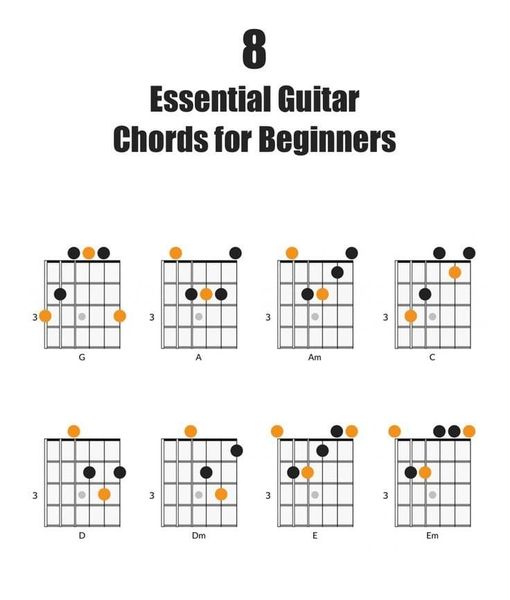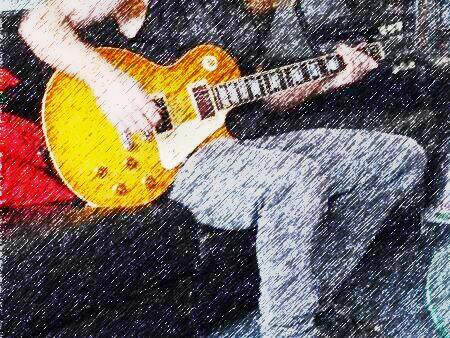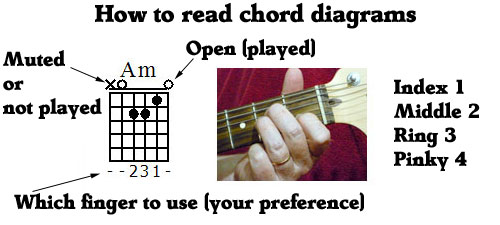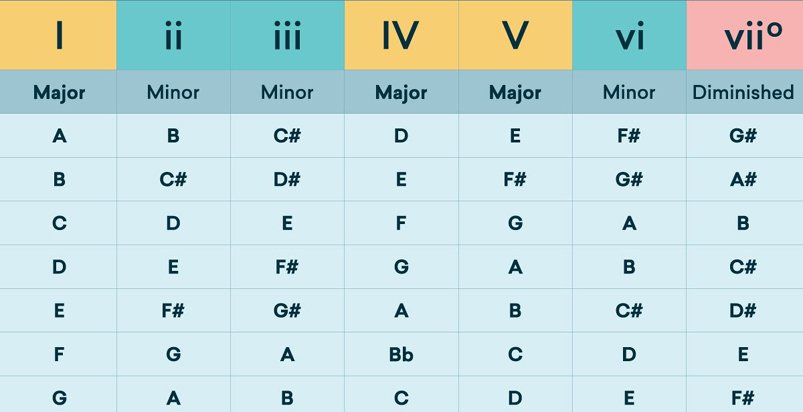How To Play Basic Chords On Guitar: Learn how to play basic chords on guitar with this simple and straightforward guide.
Master the five essential chords for beginners: G major, C major, D major, E minor, and A minor. Practice regularly and enjoy the journey of learning guitar.
Table of Contents
Hi there, Ian here!

Welcome to this simple guide to mastering the basics of guitar chords.
Whether you’re an absolute novice or just brushing up on your skills, this guide will equip you with the knowledge and techniques to confidently strum along to your favorite tunes.
So, grab your guitar, tune up those strings, and let’s dive into the world of chords.
What are chords?
Quite simply, chords are a combination of three or more notes played simultaneously. They are the building blocks of music, forming the foundation of melodies, harmonies, and progressions. Mastering a handful of basic chords will open up a vast world of musical possibilities.
Essential chords for beginners
To get you started, let’s focus on five essential chords that will have you playing along to a wide range of songs in no time. These chords are:
- G major: This chord is a staple in popular music and is relatively easy to form. Place your middle finger on the third fret of the low E string, your index finger on the second fret of the A string, and your ring finger on the third fret of the high E string.
- C major: Another common chord, C major is slightly more challenging than G major. Place your middle finger on the second fret of the D string, your index finger on the second fret of the B string, and your ring finger on the third fret of the high E string.
- D major: This chord is a bit trickier, but with practice, you’ll nail it. Place your index finger on the second fret of the G string, your middle finger on the second fret of the B string, and your ring finger on the second fret of the high E string.
- E minor: This minor chord adds a touch of emotion to your playing. Place your index finger on the first fret of the high E string, your middle finger on the second fret of the A string, and your ring finger on the second fret of the D string.
- A minor: Another essential minor chord, A minor provides a versatile sound for various genres. Place your index finger on the second fret of the third string, your middle finger on the second fret of the fourth string, and your ring finger on the second fret of the second string.
Practice makes perfect
Learning guitar chords requires patience, dedication, and regular practice. Don’t get discouraged if your fingers stumble at first. They will also get quite sore but this will pass as calouses build up your fingers, it’s a natural part of the learning process. Start by practicing each chord individually until you can form it cleanly and without hesitation. Once you’re comfortable with each chord, start transitioning between them smoothly.
Resources for further learning
Along the way, there are plenty of resources available to supplement your learning. Online tutorials and even interactive apps can guide you through the intricacies of chords and other essential guitar techniques.
Enjoy the journey
Playing guitar is a rewarding and enjoyable experience. As you progress through your learning, don’t forget to have fun and express yourself through music. With a little practice and dedication, you’ll be strumming along to your favorite songs in no time!
Happy playing!
Understanding Guitar Chords
If you’re new to playing the guitar, understanding chords is an essential first step. Chords are a group of notes played together that create a harmonious sound. They are the building blocks of most songs, and learning how to play them will help you play your favourite tunes.
There are two types of chords: major and minor. A major chord is made up of the root note, the third note, and the fifth note of a major scale. A minor chord is made up of the root note, the flattened third note, and the fifth note of a minor scale.
When you play a chord on the guitar, you are playing a specific combination of notes. Each chord has its own unique sound and can be played in different positions on the fretboard.
To play a chord, you need to know the correct finger placement for each note. This is called voicing. The voicing of a chord can change the sound and feel of the chord.
Learning basic open chords is a great place to start. These chords are played using open strings and are the foundation for many songs. Some common open chords include C major, G major, D major, A major, E major, and A minor.
It’s also important to understand musical theory when learning chords. This includes understanding the notes on the guitar, the major and minor scales, and how chords are formed.
Overall, understanding guitar chords is crucial for any beginner guitarist. Start by learning some basic open chords and then move on to more complex chords and voicings as you progress. With practice and patience, you’ll be playing your favourite songs in no time.
Getting Started
Learning to play guitar chords is an exciting journey, especially for beginners. It takes practice, patience, and dedication to master the basics, but the rewards are worth it. In this section, we will cover some essential tips to help you get started with learning guitar chords.
Holding Your Guitar

Before you start learning chords, you need to know how to hold your guitar properly. The correct posture and position will help you play comfortably and avoid injuries. Here are some tips:
- Sit on a chair with a straight-back
- Rest the guitar on your right leg (if you are right-handed)
- Keep your back straight
- Hold the guitar with your left hand on the neck and your right hand on the strings
- Adjust the strap to a comfortable height
Learning Guitar Chords
Now that you know how to hold your guitar, it’s time to start learning chords. The first chords you should learn are the basic open chords, which are the foundation of many songs. Here are some of the most common open chords:
| Chord | Fingering |
|---|---|
| C | X32010 |
| D | XX0232 |
| E | 022100 |
| G | 320003 |
| A | X02220 |
To play a chord, place your fingers on the frets indicated in the fingering chart, and strum the strings with your right hand. Start by playing each string individually to ensure that all the notes ring out clearly, then strum the chord. (The X denotes that the string is not played
Practicing Guitar Chords
In conclusion, learning to play guitar chords is a fun and rewarding experience. By following these tips, you can get started on the right foot and make progress quickly. Remember to practice regularly, be patient, and enjoy the process.
Basic Chords and Their Finger Placements

Visit this link to learn more about Guitar Tabs
Learning basic guitar chords is an essential step in becoming a competent guitar player. Here we will go over the finger placements for some of the most commonly used chords.
Major Chords
Major chords are happy, uplifting chords that are used in a variety of musical genres. Below are the finger placements for some of the most commonly used major chords:
| Chord | Finger Placement |
|---|---|
| G Major | 2nd finger on the 6th string/3rd fret, 1st finger on the 5th string/2nd fret, 3rd finger on the 1st string/3rd fret |
| D Major | 1st finger on the 3rd string/2nd fret, 2nd finger on the 1st string/2nd fret, 3rd finger on the 2nd string/3rd fret |
| A Major | 1st finger on the 3rd string/2nd fret, 2nd finger on the 4th string/2nd fret, 3rd finger on the 2nd string/2nd fret |
Minor Chords
Minor chords are sad, melancholic chords that are also used in a variety of musical genres. Below are the finger placements for some of the most commonly used minor chords:
| Chord | Finger Placement |
|---|---|
| E Minor | 2nd finger on the 5th string/2nd fret, 3rd finger on the 4th string/2nd fret |
| A Minor | 1st finger on the 2nd string/1st fret, 2nd finger on the 4th string/2nd fret |
| D Minor | 1st finger on the 1st string/1st fret, 2nd finger on the 3rd string/2nd fret |
With these finger placements, you can start playing basic chords on your guitar. Remember, practice makes perfect, so keep practicing until you can play these chords effortlessly.
Playing Chords in Different Genres
When it comes to playing guitar, knowing how to play basic chords is essential. But, it’s also important to know how to play chords in different genres. In this section, we’ll explore how to play chords in pop and rock music.
Pop
Pop music is known for its catchy melodies and upbeat rhythms. When playing pop music on guitar, it’s important to focus on the rhythm and strumming pattern. Pop music’s most common strumming pattern is a downstroke on each beat. This creates a steady rhythm that is easy to follow.
To play chords in pop music, you’ll need to know a few basic chords. The most common chords in pop music are C, G, Am, F, and Dm. These chords are easy to play and can be used to play many popular songs.
Rock
Rock music is known for its heavy guitar riffs and guitar solos. When playing rock music on guitar, it’s important to focus on the rhythm guitar part. The rhythm guitarist plays the chords that provide the foundation for the song.
To play chords in rock music, you’ll need to know power chords. Power chords are simple two or three-note chords that are played on the lower strings of the guitar. They are used in many rock songs and are great for creating a heavy sound.
The most common power chords in rock music are E5, A5, and D5. These chords are played by placing your index finger on the root note (the note on the lowest string) and your ring finger on the note two frets higher.
While the rhythm guitar part is essential in rock music, the lead guitar part is also important. The lead guitarist plays guitar solos and fills that add excitement to the song. To play lead guitar, you’ll need to know how to play scales and arpeggios.
Playing chords in different genres requires different techniques and skills. In pop music, focus on the rhythm and strumming pattern, while in rock music, focus on the power chords and lead guitar parts. With practice, you’ll be able to play chords in any genre with confidence.
Chord Progressions and Changes

Now that you have learned some basic chords, it is time to start practicing chord progressions and changes. A chord progression is a sequence of chords played in a specific order. Learning chord progressions is essential to playing songs on the guitar.
The most common chord progression is the I-IV-V progression. In this progression, you play the 1st, 4th, and 5th chords in a key. For example, if you are in the key of C, the I-IV-V progression would be C-F-G. This progression is used in countless songs and is a great place to start.
Another common progression is the I-V-vi-IV progression. In this progression, you play the 1st, 5th, 6th, and 4th chords in a key. For example, if you are in the key of G, the I-V-vi-IV progression would be G-D-Em-C. This progression is used in many popular songs and is a great progression to learn.
When playing chord progressions, it is important to focus on chord changes. A chord change is the movement from one chord to another. Smooth chord changes are essential to playing songs on the guitar. Practice changing chords slowly at first, and then gradually increase your speed.
It is also important to pay attention to the root note of each chord. The root note is the note that gives the chord its name. For example, the root note of a C chord is C. Understanding the root notes of chords will help you understand chord progressions and changes.
Finally, it is important to remember that chord progressions should support the song’s melody. The melody is the main musical theme of the song. When playing a song, make sure that the chord progression complements the melody.
Chord progressions and changes are essential to playing songs on the guitar. Practice common progressions like the I-IV-V and I-V-vi-IV, focus on smooth chord changes, pay attention to the root note of each chord, and make sure that the chord progression supports the melody of the song.
Frequently Asked Questions
What are some easy guitar chords for beginners?
If you’re new to playing guitar, you’ll want to start with some easy chords. Some of the easiest chords to learn are A, D, and E. These chords use only a few fingers and are used in many popular songs. Another easy chord is G, which is a bit more challenging but still a good one to learn early on.
How can I learn basic chords on the guitar?
The best way to learn basic guitar chords is to practice, practice, practice! Start with the easy chords mentioned above and work your way up to more challenging ones. You can find chord diagrams online or in guitar books to help you learn the finger placements. It’s also helpful to watch videos or take lessons from a guitar teacher.
What are the most important chords to learn on guitar?
There are a few chords that are considered essential for every guitarist to know. These include the major chords C, D, E, G, and A, as well as the minor chords A, D, and E. Once you know these chords, you’ll be able to play a wide variety of songs.
What are some simple guitar songs to practice basic chords?
If you’re looking for some easy songs to practice your basic chords, try “Knockin’ on Heaven’s Door” by Bob Dylan (G, D, Am chords), “I’m Yours” by Jason Mraz (G, D, Em, C chords), or “Wonderwall” by Oasis (Em, G, D, A chords).
What are some useful guitar-learning apps for beginners?
There are many great guitar learning apps available for beginners. Some popular ones include Yousician, Guitar Tricks, and Fender Play. These apps offer lessons, practice exercises, and even feedback on your playing.
Conclusion
Congratulations! You have learned the basics of playing guitar chords. By now, you should be able to play the eight basic chords: A, C, D, E, G, Am, Dm, and Em. Remember to practice regularly and focus on your finger placement and strumming technique.
Learning guitar chords is a crucial step in becoming a skilled guitarist. It takes time, patience, and practice to master the chords and progress to more complex music. Don’t get discouraged if it takes you longer than you expected to learn a particular chord or song. Keep practicing and you will get there.
It’s important to note that while mastering guitar chords is essential, it’s not the only aspect of playing guitar. To become a well-rounded guitarist, you should also focus on developing your rhythm, timing, and ear training skills. Additionally, learning music theory can greatly enhance your understanding of chords and how they work together.
Whether you’re playing for fun or pursuing a music career, learning guitar chords is an exciting and rewarding journey. Keep practicing and enjoy the process of becoming a skilled guitarist.
